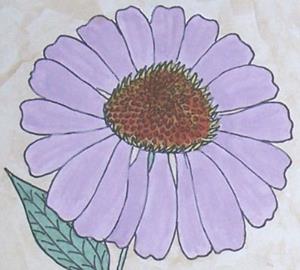- Home
- Artist Directory
- RUTH J JAMIESON
- Art Portfolio
- ECHINACEA PURPUREA

I have always loved ‘Botanical Prints’. I decided for this show to create one of my own. I created this piece using ink and watercolours on clay coated paper.
Echinacea Purpurea is one of nine recognized species of Echinacea. Classified by Moench in 1774, the scientific designation for this plant is as follows:
Kingdom: Plantae Order: Asterales Family: Asteraceae Subfamily: Asteroideae Tribe: Heliantheae Genus: Echinacea Species: Purpurea
This multi-stemmed plant grows from zone 4 to 10. Different varieties grow to different heights. The plant has high drought tolerance, likes good drainage and partial shade. Of interest is the fact that this plant does not tolerate salt well and so is not suitable for environments where salt is present.
Bloom season ranges from spring to summer depending on the growing zone. Leaves grow two to four inches long. Leaf type is simple; margin is serrate; shape is lanceolate; venation is pinnate. Flowers have a dark purple center and may have pink, purple or lavender petals.
The plants have a taproot and finer support and feeder roots. The root is harvested and used for medicinal purposes.
Other species of Echinacea include: Augustofolia, Atrorubens, Laevigata, Pallida, Paradoxa, Sanguina, Simulata, and Tennesseensis.
Echinacea has been bred into many hybrids with many different heights, growth habits, cone shapes and sizes and petal habits, shapes and colours. A garden filled with various echinacea varieties could very well be a rainbow of colour and a tapestry of texture.
I intend to do a series of botanical pieces and these will become available as prints as they are created.
Comments
By commenting, you agree to our Community Guidelines.
















